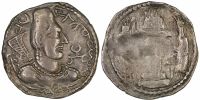Dear visitors,
please note that our National Research Network "The Cultural History of the Western Himalaya from the 8th Century (S98)" - generously sponsored by the Austrian Science Fund - has ended on June 30th 2013. For that reason this website will no longer be updated on a regular basis.
For information on our ongoing research, events and activities please refer to the website of our Center for Interdisciplinary Research and Documentation of Inner and South Asian Cultural History (CIRDIS).
Pre-Islamic Numismatic History (S 9806)
| Project Leader: | Univ.-Doz. Dr. Michael Alram |
| Members: | Dr. M. Pfisterer, Dr. K. Vondrovec, |
The project emphasizes the later pre-Islamic numismatic history of the Western section of the Western Himalayas from Afghanistan to Kashmir including the areas of Central Asia. The chronological framework stretches from the late fourth to the eighth century CE, when Hunnic and Turkish tribes ruled not only in ancient Sogdiana and Tokharistan but also shifted their centres of power across the Hindukush to Kapisi/Kabul, Zabul, Gandhara, and Northwest India.
Coins are a most important source for both the history and culture of the Iranian Huns, since hardly any written documents of their own are known. On their coinage they use three different languages (Bactrian, Brahmi, Pehlevi), which were naturally foreign to them.
The research aims to revise Robert Göbl´s fundamental work Dokumente zur Geschichte der Iranischen Hunnen in Baktrien und Indien, published in 1967, and to thereby provide a firmer historical basis for this region through a refined and updated numismatic political history. In the last decades thousands of new coins have come to light, and, most important of all, a great number of formerly unknown new types haev been discovered. Almost every new specimen represents an important addition to the jigsaw puzzle assembled thus far and ultimately must be related to literary evidence as well as to archaeological and art historical data.
In addition to the stock of all major European coin-collections, the coin-finds from the site of Kashmir-Smast (Pakistan) as well as the exquisite private collections of Jean-Pierre Righetti (Switzerland) and Aman Ur Rahman (Pakistan / UAE) will be included into our research. Material from public collections in Pakistan will deliver further necessary archaeological background information.



